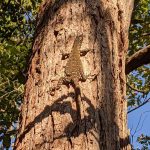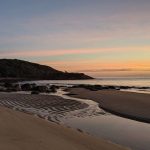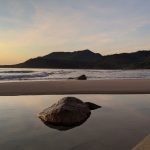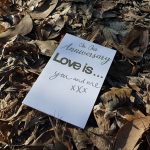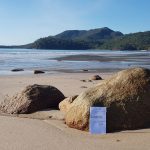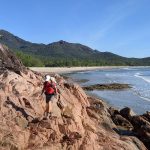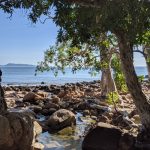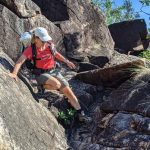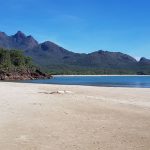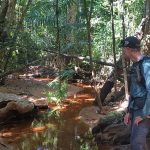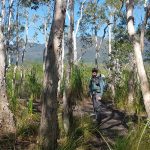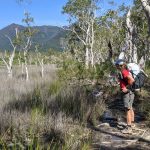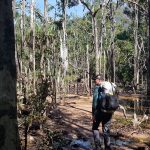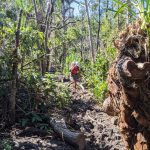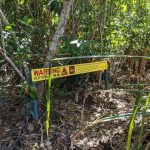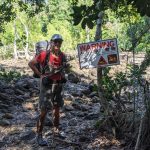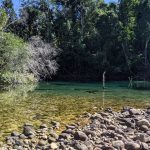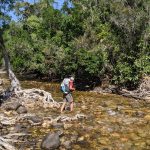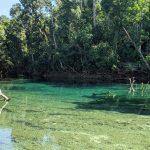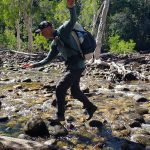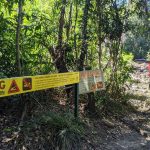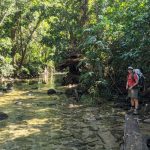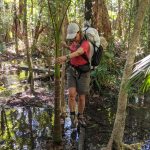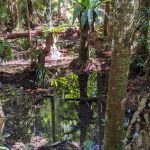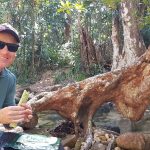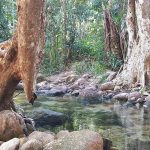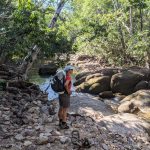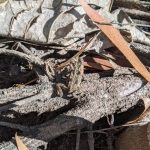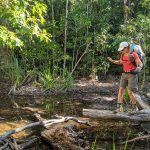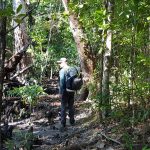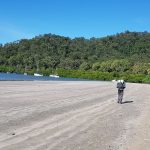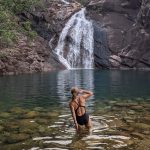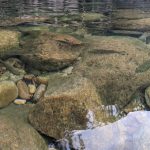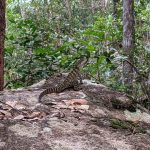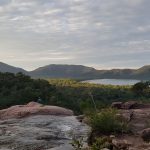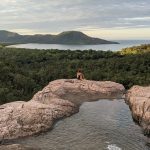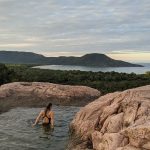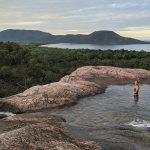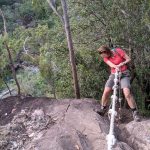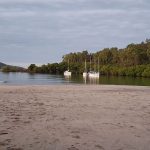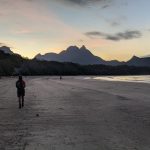Saturday 17th July, 2021
Happy anniversary to us.
Three years of marriage in an amazing 29 years together. Yay us. David got up for sunrise this morning and saw a lace monitor up a tree and a magnificent sunrise. I was too scared to go out on the beach at dawn because of the crocodiles and prayed David would be safe. I really should have done some research on croc behaviour before we left. Oh well.
What an amazing day. We climbed over boulders, hopped over rocks, walk along the beach, up and down huge hills, crossed many creeks, DB fell in one, I tripped on a reed and landed on my hands and knees with my heavy pack on my back. Luckily I was not hurt. We walked through swamps, I ended up rushing in up to my knees after DB said there had been a recent croc sighting, we talked to some young girls (one a park ranger and the other a biologist) at the crocodile creek, went through rainforest, more swamps, passed amazing trees, through more creeks, then we finally made it to Zoe Bay camp site. We setup camp and then walked up to the falls, had a swim, walked up further and had another swim in an infinity pool. A big day with the most diverse range of track conditions and scenery. An awesome anniversary. 10.5km over 6 hrs. Another tough day at the office. DB had to carry my water today just to reduce my pack weight by 2kg as it was a struggle early in the day for me. We enjoy each day meeting new people along the track and at camp. It makes for interesting conversation hearing about their travels and favourite hikes, it is amazing how much you can learn about someone’s life in 30 mins. We are now over half way. 17km done, two more 7.5km days to go.
Day 2 – Track Notes
Little Ramsay Bay to Zoe Bay (Grade: difficult)
Distance: 10.5 km Time: allow about 6 hrs hiking time
From Little Ramsay Bay the trail proceeds south, crossing a tidal creek and continuing to rocks at the end of the beach. The next beach is then accessed by rock hopping around the small headland. At the end of this beach, the trail leads to the upper edge of rocks above a larger sandy beach. From the southern end of this beach the trail heads south-easterly through a small gully to the top of a ridge. At this point, a side path leads to Banksia Bay (600 m return) and a small camping area. This bay has spectacular fringing reefs and golden orchids can be seen growing on the beachside rocks.
The main trail continues south, descending to the Banksia Creek crossing and onwards south- east to the saddle between Banksia and Zoe bays. At the top of the saddle the trail then descends a rocky creek into the Zoe Bay catchment. Turning south-south-west, the trail travels to North Zoe Creek through a succession of vegetation types, from dry open forest to rainforest and mangrove swamps. The variation in rain, fire and drainage are the driving forces behind the distribution of these vegetation types.
The trail then passes through several palm swamps in tall rainforest between North Zoe Creek and Fan Palm Creek The trail may be less visible in these areas. Look carefully for the trail markers. The most reliable water sources in this section are found where the trail crosses Fan Palm Creek and Cypress Pine Creek. The rainforest here is ideal for bird watching and the deep ‘wallock-a-woo’ call of the brightly coloured but elusive wompoo fruit-dove can sometimes be heard from within the canopy. Look out for the hooked tendrils of the yellow lawyer cane and hairy mary C. australis. These climbing palms use hook-studded branches to support growth towards the canopy. Although not poisonous, these tendrils can take a firm hold of hikers’ skin, packs and clothing. Be prepared to get your feet wet as there are several creek crossings and swampy sections. The trail enters the beach at Zoe Bay with the mouth of South Zoe Creek about 400 m to the south.
The spectacular Zoe Falls are a few minutes along the track from the camping area and are well worth a visit. There is no camping at Zoe Falls please camp in the camping area. At low tide look for armies of small, blue soldier crabs on the sand flats near the mouth of South Zoe Creek. From the southern end of the beach the trail leads through magnificent rainforest featuring the orange trunks of alligator bark and the tall, buttressed blue quandong. The bright blue fruits of the quandong often litter the forest floor. Large eucalypts emerge above the rainforest canopy, suggesting that this has not always been a rainforest, but that over the last few decades, the absence of fire has caused the rainforest to invade open eucalypt forest.
- Success for David on his early morning walk he managed to capture a photo of a small lace monitor on the tree..
- ..as well as some beautiful sunrise photos of Little Ramsay Bay..
- ..and Warrawilla Creek at Little Ramsay Bay..
- ..and another one, sorry I couldn’t decide on which ones to include..
- ..so I gave you a few too many – Looking across the mangroves and Warrawilla Creek to Mt Bowen at sunrise..
- ..and then back out to Little Ramsay Bay, the colours were magnificent..
- ..and another one of Warrawilla Creek Little Ramsay Bay..
- ..and a little later in the morning.
- A little green ant sat with us for breakfast..
- ..as we shared a lovely morning on our 3rd wedding anniversary..
- ..it was a spectacular view to celebrate another year of our 29 years together, another wonderful milestone.
- Off again, heavy packs on and walking along the beach as we leave Little Ramsay Bay..
- ..time to get those quads working as they are needed to help push you up and over the rocks with the heavy pack on your back..
- ..as we cross Banksia Creek..
- ..and head around to Banksia Bay..
- ..as the rock climbing and descending gets a little trickier..
- Banksia Bay looking back to Little Ramsay Bay..
- The colour of the creek here is an amazing reddish orange which I think may have been from the runoff from a landslide..
- Amazing paperbark trees in the swamp..
- .as it starts to get wetter underfoot..
- ..and wetter where we have to try to keep dry..
- ..as the terrain quickly changes to swamp , where keeping above the mud is near impossible, it takes lots of time to navigate in the least sloshy, deep soft mud..
- ..now it is my turn..
- ..David sees this sign as well as a warning about a croc sighting in the last seven days..
- ..he conveys this to me by saying “there has been a croc here” which as you can see by my muddy legs plunges me straight in to the swamp to get to him as quickly as possible, in hindsight I probably should have kept moving around the edges, but my fear didn’t allow it. Very grateful for the reef shoes we picked up at Innisfail as I hate squelchy slimey mud..
- ..North Zoe Creek looked beautiful but it was a definite crocodile danger, we met a ranger and a botanist here having morning tea..
- ..luckily where we had to cross was shallow and not croc friendly..
- ..and looking back into the water you could see clearly but no swimming here..
- ..David’s turn to cross the creek – he almost comes a cropper..
- ..this is the sign at Zoe creek that David saw that sent me into the swamp. These make it very REAL.
- Another sign on the other side of Zoe Creek to warn the hikers travelling South to North..
- Another creek to cross a little further along – Fan Palm Creek..
- Then some tricky stuff along tree trunks, as we didn’t want to take our shoes off but DB should have, as his tree climbing skills saw him plunge into the water. Wet feet and shoes now for the rest of the day….
- ..my turn to navigate the water at Fan Palm Creek but I went a different way to try to stay dry..
- ..it was tricky but I made it..
- ..we decided to have lunch at Fan Palm Creek amongst the amazing trees..
- ..with their incredible exposed root systems and the beautiful clear creek water..
- ..such amazing trees along the creeks..
- ..check out the throne or bowl shaped trunk or a claw footed bathtub..
- ..how David saw this little frog camouflaged in the leaves I don’t know, but it must have moved because it was so hidden..
- ..and another creek to cross..
- ..this time requiring a little balancing act and concentration which as you get older gets more difficult..
- ..as we come to more swamp in the rainforest..
- ..and finally at last on to the beach at Zoe Bay, it has been a tough day of climbing, squelching, balancing and rock hopping over 10.5km in about 6 hours..
- ..and now the reward of a refreshing bath at the base of Zoe Waterfall..
- ..and a beautiful swim as well..
- ..the water was crystal clear you can even see some fish just hovering waiting to nibble at my toes..
- ..a little friend of David’s – the water dragon – as we walk to the top of Zoe Falls..
- ..in time for sunset over Zoe Bay..
- ..it was a spectacular view in peaceful serenity (as the ghetto blaster had gone back down to camp)..
- .. the water was a little cool..
- .. but quite pleasant once you got in..
- ….we were lucky enough to have the spot all to ourselves..what a day..
- ..this was the only way back down to camp from Zoe Falls – a little rope descent, shall be interesting going back up tomorrow with a full heavy pack…
- ..as we return to Zoe Bay just before the sun is down we have some visitors from the mainland that arrive at camp the easy way..
- ..we make the final walk to our camp, use will need some torchlight to cook dinner tonight.
